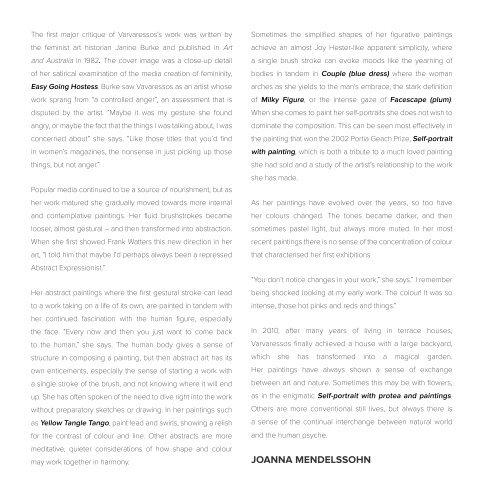SRGN_VickiV_Catalogue_42pp+4pp_PROOF_LowRes
Create successful ePaper yourself
Turn your PDF publications into a flip-book with our unique Google optimized e-Paper software.
The first major critique of Varvaressos’s work was written by<br />
the feminist art historian Janine Burke and published in Art<br />
and Australia in 1982. The cover image was a close-up detail<br />
of her satirical examination of the media creation of femininity,<br />
Easy Going Hostess. Burke saw Vavaressos as an artist whose<br />
work sprang from “a controlled anger”, an assessment that is<br />
disputed by the artist. “Maybe it was my gesture she found<br />
angry, or maybe the fact that the things I was talking about, I was<br />
concerned about” she says. “Like those titles that you’d find<br />
in women’s magazines, the nonsense in just picking up those<br />
things, but not anger.”<br />
Popular media continued to be a source of nourishment, but as<br />
her work matured she gradually moved towards more internal<br />
and contemplative paintings. Her fluid brushstrokes became<br />
looser, almost gestural – and then transformed into abstraction.<br />
When she first showed Frank Watters this new direction in her<br />
art, “I told him that maybe I’d perhaps always been a repressed<br />
Abstract Expressionist.”<br />
Her abstract paintings where the first gestural stroke can lead<br />
to a work taking on a life of its own, are painted in tandem with<br />
her continued fascination with the human figure, especially<br />
the face. “Every now and then you just want to come back<br />
to the human,” she says. The human body gives a sense of<br />
structure in composing a painting, but then abstract art has its<br />
own enticements, especially the sense of starting a work with<br />
a single stroke of the brush, and not knowing where it will end<br />
up. She has often spoken of the need to dive right into the work<br />
without preparatory sketches or drawing. In her paintings such<br />
as Yellow Tangle Tango, paint lead and swirls, showing a relish<br />
for the contrast of colour and line. Other abstracts are more<br />
meditative, quieter considerations of how shape and colour<br />
may work together in harmony.<br />
Sometimes the simplified shapes of her figurative paintings<br />
achieve an almost Joy Hester-like apparent simplicity, where<br />
a single brush stroke can evoke moods like the yearning of<br />
bodies in tandem in Couple (blue dress) where the woman<br />
arches as she yields to the man’s embrace, the stark definition<br />
of Milky Figure, or the intense gaze of Facescape (plum).<br />
When she comes to paint her self-portraits she does not wish to<br />
dominate the composition. This can be seen most effectively in<br />
the painting that won the 2002 Portia Geach Prize, Self-portrait<br />
with painting, which is both a tribute to a much loved painting<br />
she had sold and a study of the artist’s relationship to the work<br />
she has made.<br />
As her paintings have evolved over the years, so too have<br />
her colours changed. The tones became darker, and then<br />
sometimes pastel light, but always more muted. In her most<br />
recent paintings there is no sense of the concentration of colour<br />
that characterised her first exhibitions<br />
“You don’t notice changes in your work,” she says.” I remember<br />
being shocked looking at my early work. The colour! It was so<br />
intense, those hot pinks and reds and things.”<br />
In 2010, after many years of living in terrace houses,<br />
Varvaressos finally achieved a house with a large backyard,<br />
which she has transformed into a magical garden.<br />
Her paintings have always shown a sense of exchange<br />
between art and nature. Sometimes this may be with flowers,<br />
as in the enigmatic Self-portrait with protea and paintings.<br />
Others are more conventional still lives, but always there is<br />
a sense of the continual interchange between natural world<br />
and the human psyche.<br />
JOANNA MENDELSSOHN<br />
Joanna Mendelssohn began her professional career<br />
at the Art Gallery of New South Wales and later worked<br />
for the Newcastle Region Art Gallery and the S.H. Ervin<br />
Museum and Art Gallery. As the award-winning art critic<br />
for The Bulletin and in other publications she has written<br />
extensively on Australian art including for The Conversation<br />
and was one of the instigators of Design & Art Online<br />
(www.daao.org.au). Her previous books include The life &<br />
work of Sydney Long (1979), Lionel Lindsay: An artist and<br />
his family 1988) and Letters & Liars: Norman Lindsay and<br />
the Lindsay Family (1996). She is currently an honorary<br />
associate professor at UNSW Art & Design, where she was<br />
for many years Program Director for Art Administration.<br />
Her most recent book is Australian Art Exhibitions:<br />
Opening Our Eyes (Thames and Hudson 2018) which<br />
she co-authored with Catherine De Lorenzo, Catherine<br />
Speck and Alison Inglis.<br />
ENDNOTES<br />
*Quotations are from the author’s interview with Vicki Varvaressos in July 2018.


